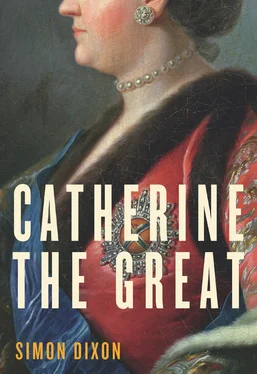In 1750, Peter and Catherine enjoyed a brief return to Peter the Great’s summer house while their new rooms in the Summer Palace were being finished. The ground floor at Monplaisir, where they spent part of that summer, was also ‘fairly pleasant’ because there were windows on both sides. But these were exceptions that proved the rule. It rained so hard that year that the landings at Yekaterinhof were ‘covered in pools of water’, and the new Summer Palace rooms which had initially promised much, being further from Elizabeth’s part of the palace than before, turned out to overlook the Fontanka—dismissed by Catherine as ‘nothing but a muddy swamp’ before its banks were clad with granite in her own reign—and ‘an ugly, narrow little courtyard on the other side’. 88The apartments they replaced had been even less satisfactory:
This was an enfilade of double rooms which had only two exits: one via the staircase, through which everyone who came to see us had to pass; and the other adjoining the empress’s staterooms, so that our servants were obliged to pass through one or other of these exits with the necessary, and one day it happened that when one of the foreign ministers (I don’t remember which) arrived for an audience, the first thing he encountered was a commode being taken away to be emptied. 89
The only escape from such privations lay at their country estate at Oranienbaum, attractively situated on rising ground overlooking Kronstadt and the Gulf of Finland, four miles west of Peterhof. Here Catherine and Peter had ‘more freedom’ than in town, though it was to be some time before they could count themselves as masters of their own household. 90Built in the 1720s for Peter the Great’s corrupt favourite, Alexander Menshikov, the palace bore several marks of his insatiable vanity: subtly in the form of a personalised iconostasis, and more brazenly in the form of a monstrous princely crown, carved in stone on top of the main building. After Menshikov’s disgrace in 1727, the estate fell rapidly into disrepair. Although Sir Francis Dashwood reckoned Oranienbaum ‘with the additions of art very grand’, the future founder of the Hellfire Club noted that it was already ‘going the way of their other buildings’ when he visited it in 1733. 91Three further years of neglect were to follow before the palace was requisitioned for use as a naval hospital, whose patients were transferred to Kronstadt when Elizabeth granted the estate to Peter in November 1743. By then, serious work was required to make the place inhabitable and it is not surprising that Catherine should have remembered it as being ‘in a fairly dilapidated state’ when they first began to spend time there in 1746. 92
At that point, traipsing in the wake of the restless Elizabeth, she and her husband were rarely able to spend more than a week at a time ‘in the country’. Perhaps it was just as well. Until 1750, their estate was little more than a building site as thousands of the grand duke’s serfs laboured to transform it into a cross between a summer palace and a military encampment. The first project to be completed in 1746 was a small but heavily armed fortress which may have been partly designed by Peter himself. Built near the pond to the south of the palace, the fortress was christened ‘Yekaterinburg’ in Catherine’s honour. Yet her husband’s obsession with his soldiers drove her to distraction. Everyone, from the leading courtiers down to the household servants, was forced to march about with muskets on their shoulders, as Peter was finally able to indulge his passion for military drill. While he drove his troops up and down the parade ground, Catherine was left to a ‘detestable’ life playing shuttlecock with her maids of honour. Reading and hunting were her only consolations. 93
Prospects temporarily improved in the following spring, when work began on the conversion of Menshikov’s stables into an opera house. But this was soon abandoned, apparently because the master stonemason in charge of the works was anxious not to destroy the effect of the façade. An alternative site was approved in August, but progress was delayed by the disaster at Gostilitsy. This prompted a safety inspection of all the imperial palaces in the summer of 1748, forcing Catherine and Peter to move into one of the wings attached to the main building and to dine in a tent in the courtyard. The inspectors’ efforts were ultimately in vain, since fire destroyed the new buildings at Oranienbaum in September 1748, along with Menshikov’s bell tower. 94Construction restarted only after the Court had left for Moscow in December and it was not until 25 July 1750 that Peter could celebrate the completion of the first stage by throwing a lavish ball for the empress and 450 guests, including the foreign ambassadors. ‘There was also a very fine illumination,’ the British Resident reported, ‘and Her Imperial Majesty took this occasion to make the great duke a present of sixty thousand roubles to finish the additional buildings and improvements.’ 95
Having enjoyed hunting with Aleksey Razumovsky on the Court’s visit to Reval in 1746, Peter acquired a pack of hounds at Oranienbaum the following summer. Catherine, who mocked his sporting prowess in every version of her memoirs, complained that he ‘tortured’ his dogs and kept them chained up in a room adjoining their palace apartments over the winter of 1747. This, however, was all part of a strategy designed to depict her husband as a brutal ingrate, all the more suspicious for consorting with German huntsmen. 96While Elizabeth was on her pilgrimage to the Trinity monastery in 1749, Catherine herself rode out into the fields almost every day. So sunburned was she on arrival at Bratovshchina at the end of June that the empress sent her a rinse made of lemon, egg white and French eau de vie to restore her complexion: ‘When the skin is overheated, I know of no better remedy.’ 97
By her own account, however, she took little pleasure from the chase: it was riding that she found exhilarating—‘and the more violent the exercise, the more I enjoyed it’. At Oranienbaum the following summer, she hunted ‘every day that God granted, sometimes spending thirteen hours a day on horseback’. 98Generations of biographers have made much of this passion for riding, seeing it as a means of relief for everything from sexual frustration to premenstrual tension. Perhaps it was. But it is just as plausibly explained as a healthy escape from dank, smoke-filled palaces. Catherine certainly thought so. She told the doctor who inoculated her against smallpox in 1768 that although she had taken asses’ milk and spa water for seven years to relieve her weakened lungs in the wake of her illness in 1744, she attributed her recovery largely to riding. 99In her memoirs, Catherine presented her prowess on horseback somewhat differently, as a symbol of courage and virility. By refusing to ride side-saddle, even when the empress complained that riding astride was unseemly and might prevent her from conceiving a child, she could ‘keep up with the most determined huntsmen’. Indeed, she liked nothing better than to dress ‘from head to toe’ in male attire for a day’s duck shooting in the reeds of the Oranienbaum canal with an old hunter who sometimes took her further out to risk the open sea. 100
* * *
Back in St Petersburg for the winter of 1750–51, Elizabeth revived her cross-dressing balls, events for between 150 and 200 guests at which ‘most of the women resembled stunted little boys’. As Catherine later complained, ‘the eldest had fat, short legs that hardly flattered them’. Only the empress was displayed to advantage: ‘She had more beautiful legs than I have ever seen on any man and admirably proportioned feet.’ 101Less bizarre, though scarcely less onerous, were the public masquerades held every autumn and at New Year. Guests arrived between half past six and eight, briefly dropped their masks at the door to establish their noble status, surrendered their weapons (if they had been naïve enough to suppose that daggers were a legitimate part of Turkish costume) and entered a fantasy world that lasted long into the night. No alcohol was served, but liveried pages were on hand to offer tea, coffee, lemonade, orshad (a milky drink made with almonds), a variety of luscious fruits and piles of the ubiquitous sweets. Music began at half past seven and continued until the early hours. Dinner was usually served between midnight and two in the morning, when Catherine and her husband sat down with dignitaries of the top two ranks before dancing the night away. It was a test of endurance to survive these entertainments in the first six weeks of the New Year, when up to seven of them were held as little as three or four days apart with theatrical performances sandwiched in between. Since sickness was rife at that time of year, it is perhaps not surprising that only 665 nobles appeared at the first masked ball of 1751, though more than 1400 tickets had been issued and the Academy of Sciences was ordered to publish an attendance of ‘as many as 1500 guests’ in the newspapers. 102‘One pretended to be entertained by them,’ Catherine later wrote of these balls, ‘but in fact one was bored to death.’
Читать дальше












